Cold & colder
The days come and the days go, and with the certitude of time passing, a welcome change occurs with the arrival of visitors. Our niece, Shannon, regularly graces us with visits, bringing ideas for Arizona activities. Her latest destination wish was a tour of Antelope Canyon, a much photographed marvel in northern Arizona, and we were happy to oblige.
Dead horse, Cottonwood, Sullivan Lake . . .
In the days prior to our journey north, we enjoyed some time in the Verde Valley soaking up what rays of sunshine were available, primarily because Prescott's unseasonably cold and windy weather persisted past any semblance of when I deemed it should be at an end.
We sauntered around Dead Horse State Park on the Verde River . . .
. . . watching the winter resident bald eagle, and playing on the zip line designed for children (the only kind I will ever use and even then, I had to be coaxed).
For some reason, having our picture taken turned into a session of hilarity. Evidently, you had to be there; however, I was there and still don't know what set us off.
Further escapades followed as we window-shopped at old town Cottonwood. Possibly due to the señor's steadying influence, we escaped being tossed out on our ears from any of the mercantiles and galleries.
Our hoped-for escape from the wind did not materialize, unfortunately: brisk breezes followed us and probably affected the smallish number of birds we identified. It is typically a super place to see many species, or perhaps we were just too busy laughing to pay attention.
We did manage to note the presence of double-crested cormorant, ruby-crowned kinglet, western bluebird, yellow-rumped warbler, red-winged blackbird, pied-billed grebe, northern flicker, great-tailed grackle & raven.
Voluminous amounts of rain at strategic times over the winter and spring resulted in flooding in many areas. The dam at Sullivan Lake backed up an impressive amount of water as Big Chino Wash flowed over it into the Verde River Gorge. A week before Shannon's visit we had marveled at it; the flow was much diminished when we took her there, but still impressive, especially considering that the silted-in lake is typically dry.
A few rock buildings remain roofless around the perimeter of what was the lake's shores. They date from the 1930s when the place was touted as a sportsman's facility constructed as a WPA project.
Antelope Canyon . . .
As the time neared for our Antelope Canyon tours, we headed north to our lodging at Marble Canyon with a stopover viewpoint below Glen Canyon Dam that created Lake Powell.
Unceasingly it seemed, a cold wind kept us from much lollygagging.
Many years ago, we had perused both upper & lower Antelope; that was long before the place was "discovered" by the hordes. For that long-ago time, we had the place to ourselves to wander and be amazed at the stunning swirling shapes and hues created by wind, water & sand. Now, however, one pays a fee and makes a reservation to be guided through in the company of a small group, one of a seemingly endless stream of humanity wanting to share the experience.
Despite the change that time and interest has brought, the beauty of the canyon continues to be awe-inspiring even after seeing innumerable photographs of it through the years. Although hundreds of folks were queued up in lines akin to ants scurrying forth with provisions for the den, it was well managed, allowing us to experience the canyon with a sense of leisure.
And at least we were out of the wind.
In keeping with the weather patterns that I have railed about of late, we cancelled our anticipated stop at Horseshoe Bend in the Colorado River. Along the way, we pulled out for a view across the valley to Kaibab Plateau and were buffeted by frigid wind-swept snow & sleet; none of us thought a hike sounded in the slightest attractive in those conditions.
Lee's Ferry, Lonely Dell, Vermilion Cliffs . . .
Ah, a respite from horrid weather: conditions upgraded to chilly breezes and blue skies, and just in time for our wanders in the Lee's Ferry area where the Paria flows into the Colorado, and where history melds with larger-than-life multi-hued landscapes.
Miles and miles of the Echo Cliffs dwarf Navajo dwellings spotted here and there near its base . . . and then the Vermilion Cliffs fairly trumpet their massiveness on the north side of the Colorado. That is where history was made when Mormon pioneer John D. Lee, and others, envisioned and constructed a road dropping along the sheer cliffs to a place where he maintained a ferry crossing into country formerly occupied only by natives. Remains of the built-up rock-sided route can still be seen across the water; I am incredulous every time I see it as I wonder at the audacity of the undertaking, and the nerves of steel surely necessary to traverse it.
Lee was a polygamist; he & one of his wives, Emma, were joined by other intrepid colonists in the construction and maintenance of an extensive agricultural settlement along the Paria River at its confluence with the Colorado, allowing those who followed them access to a vast swath of unexplored countryside. Emma called the place a "lonely dell" for its extreme isolation, a name that persists to today.
Lee's history is interesting, revolving around many involvements with the LDS church that sent him there, and in the 1850s as a participant in the Mountain Meadows Massacre, for which he was later executed by firing squad. Emma kept Lonely Dell Ranch operating for a time after her husband's death.
Structures of various vintages sparsely dot the countryside.
It seems that mankind has always had a yen to leave a mark, although it's far easier with modern spray paint than the former painstaking pecking and scratching away on rocks.
A plethora of interpretive signs reveal some of the region's history while offering photographs from days past.
At one time, and only for a very short time, there was a steamboat operating on the river. Some of it is visible below the surface with a portion above the water.
We wandered into the back reaches of the ranch property alongside the homestead's burying ground: a trail winds along the cliff's edge above the Paria through some mighty fine country.
That route continues north into Utah; it is a favored backpacking trail known for stunning slot canyons, arches, springs and petroglyphs. Its lure is almost sufficient to induce me into a several-day backpacking journey.
Exploring - Beauty & Beast . . .
Away from the river, we did some scrambles up, down and around just for the fun of it, even scouring through an old dump site. At every juncture, the scenes elicit awe, except of course where the detritus of civilization has been discarded into a canyon, and even there, we found things of interest (one man's junk, etc.) and even chunks of petrified wood.
An intriguing find, seemingly prehistoric rock art: A horizontal series of three circles, the first with a dot in the center, the second with a bar across the center, and the third with an added vertical bar. Our consensual consensus was that it related to moon phases, and marks the place as an observatory.
And again, we encountered historic grafitti, if it can be so described. That one was more complete than most: "Morris Hyatt 1938 Lawrenceberg KY March". And yes, of course I took a stab at researching him, but came up empty.
We couldn't pass up the chance to introduce Shannon to Clan Rocks, an important petroglyph site, and for the señor to offer a mini-class about its history & significance. A bonus was to see horses grazing on the sparse vegetation.
Rounding out the week's bird identifications, we saw house sparrow, house finch, common goldeneye, American coot, Canada goose, Say's phoebe, rock wren, canyon wren, Bewick's wren & white-crowned sparrow.
In all, a week with a few disappointments, but nevertheless a journey with love, laughter & adventure - what more could we want!





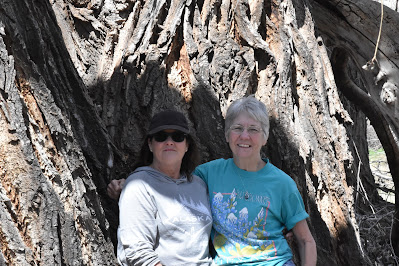




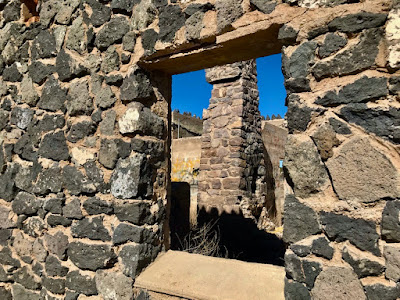






 l
l



























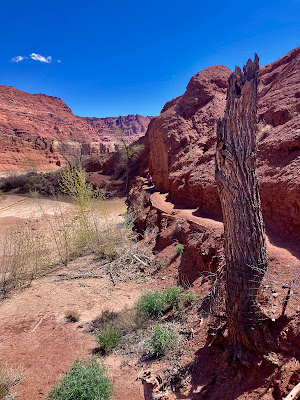
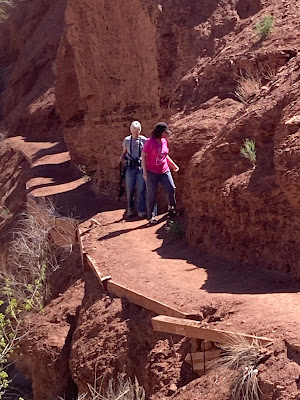



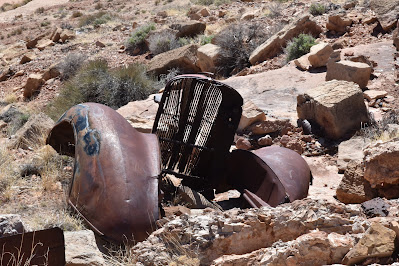









No comments:
Post a Comment